Table of Contents
The bulk of the world’s output of copper is produced by smelting copper sulfide flotation concentrates in reverberatory furnaces, followed by oxidizing the matte to blister copper in a converter. Slags produced in the converter are too high in copper to be sent to the dump and are returned to the reverberatory furnace for recovery of most of the copper. This method for re-treating converter slag, although simple, complicates the operation of the reverberatory furnace and contributes significantly to loss of copper in the reverberatory slag. An economic method for re-treating converter slag separately would increase furnace capacity, produce a lower-grade discard slag, and simplify furnace operations.
Possibilities for minimizing copper losses in converter slags include:
- (1) settling the molten slag to recover entrained matte and copper,
- (2) smelting the slag with a suitable reductant to recover a copper-iron alloy or a low-grade matte
- (3) beneficiation of slags by magnetic separation, and
- (4) treatment of the slag by flotation. Flotation appeared to offer the most promise for economical recovery of the copper.
The Bureau of Mines made flotation and grindability tests on three converter slags containing 1.6 to 6.6 percent copper. The relative merits and costs for the flotation of slow-cooled versus water-quenched slags were determined.
Description of Slag Samples
The three converter slag samples used in the investigation were obtained from a western smelter. Chemical analyses of the respective slags are presented in table 1.

Slag sample A, which contained 1.6 percent copper, comprised a 5-ton composite of four slag skims taken over a normal 14-hour converting cycle. A portion of each skim was poured into a skimming ladle, and the mass was allowed to cool slowly for 31 hours before dumping and crushing.
Sample B, containing 5.0 percent copper, was a 1-ton lot of converter slag. Neither the thermal history nor the skim from which the sample was obtained were known.
Sample C, weighing about 0.5 ton, was not a typical sample in that the copper content of 6.6 percent was higher than the 1 to 5 percent copper reported for most converter slags. However, unusually high copper slags are produced on occasion as a result of operational variations. This sample was included in the study because the retreatment process would have to handle all types and grades of converter slags. Again the thermal history was not known, but the slag was presumed to have been slow cooled.
Examination of the slag samples with an electron microprobe and a metallographic microscope indicated that the copper occurred principally as copper sulfide, approximating the composition of bornite. Most of the sulfide particles ranged in size from 10 to 45 microns. Some of the sulfides occurred as stringers, but most were present as rounded particles. Magnetite was observed both as dendrites and as well-formed crystals. Few sulfide inclusions were observed in the magnetite. The forms of copper in these slags

agree with the findings of other researchers on the occurrence of copper in smelter furnace slags. A photomicrograph of a typical slag is shown in figure 1.
Preparation of Slag Samples
Samples of slag were prepared for beneficiation and grinding studies by remelting 1-kilogram charges in an induction furnace. Samples were then cooled by pouring them into a water bath to quench the slag, by chilling the crucible and melt in air, or by slow cooling in the furnace. The water-quenched slag solidified in the form of granules, most of which were minus 6 mesh. The air-chilled and slow-cooled slags solidified in the form of single masses. Cooling curves were obtained by immersing a quartz-protected Chromel-Alumel thermocouple in the charge while recording temperatures on a strip-chart recorder. Cooling rates for the induction-furnace slow-cooled and air-chilled samples are presented in figure 2.
The quenched slags used in the grindability tests were dry crushed to minus 6 mesh, whereas those used in the flotation studies were crushed to minus 10 mesh. The slow-cooled slags were similarly crushed after breaking and separating the fire clay crucible from the solidified slag.
Specimens of the heat-treated slags were polished and examined under the microscope. In the water-quenched specimens, the bulk of the copper occurred as round inclusions that exhibited a light blue color, which is characteristic of chalcocite. Particle size ranged from as large as 10 mesh down to about 15 microns. Many of the larger chalcocite inclusions contained stringers of metallic copper. In addition to chalcocite, finer particles exhibiting
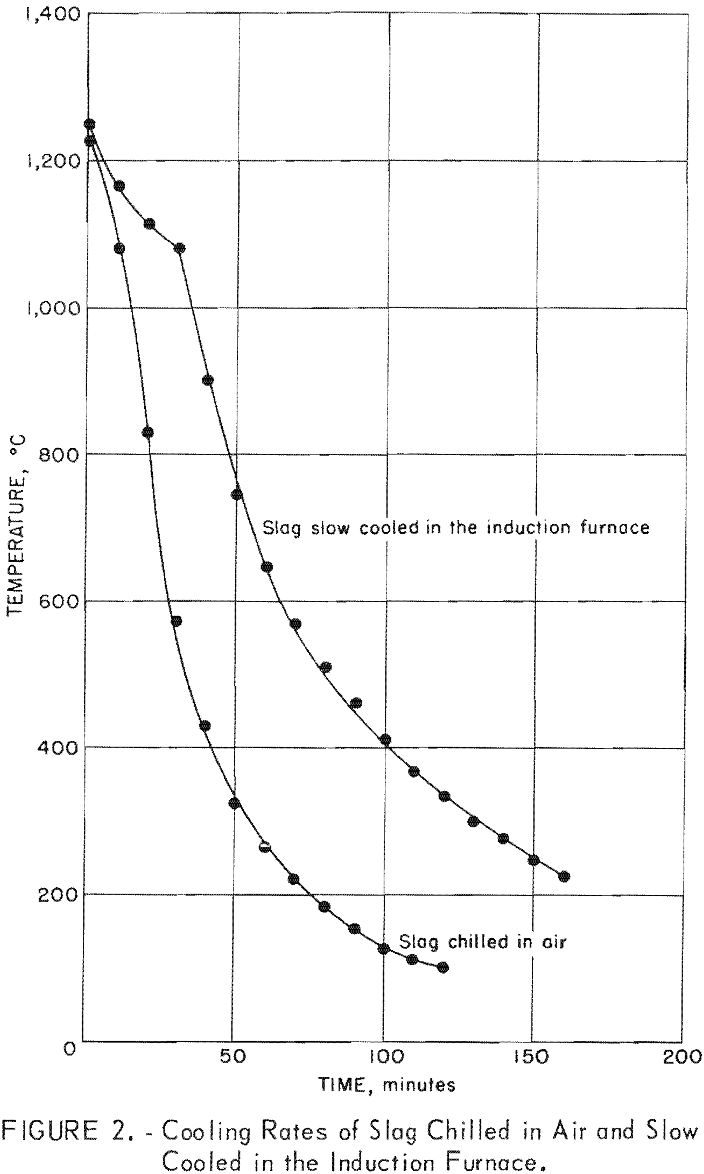
the color and characteristics of bornite were observed in the minus 15-micron range. The extremely fine size of these particles indicated that fine grinding would not materially improve copper recovery. A 60-minute grind produced only slightly higher copper recoveries than a 10-minute grind.
The slow-cooled slags were similar in appearance to the slags as received from the smelter. Both the sulfide inclusions and the magnetite crystals were more angular than those observed in the water-quenched specimens.
Batch Flotation Tests
Flotation Test Procedure
The amenability of the different slags to concentration by flotation was determined by the following procedure. Standard 500-gram charges of the dry-crushed slag were wet ground at 62.5-percent solids in an iron ball mill, wet screened to remove any plus 65-mesh metallic particles and the pH of the pulp determined. The charges were ground for 10, 30, and in some cases, 60 minutes to insure optimum liberation of the copper minerals.
Batch flotation tests were made on the ground pulp in a 600-gram Fagergren-type cell. Initially, three successive rougher concentrates were pulled. Prior to each 3-minute flotation period, the slags were conditioned for 5 minutes with 0.1 pound per ton of potassium amyl xanthate collector (KAX) and 0.18 pound per ton of methyl isobutyl carbinol frother (MIBC). Since practically all the recoverable copper was found in the first two roughers, pulling a third rougher was discontinued in subsequent flotation tests. Cleaning tests on the rougher concentrates were not made in these batch tests.
Flotation of Copper From Slow-Cooled Converter Slags
The results of flotation tests on slags cooled in air and in the induction furnace are shown in table 2-3.
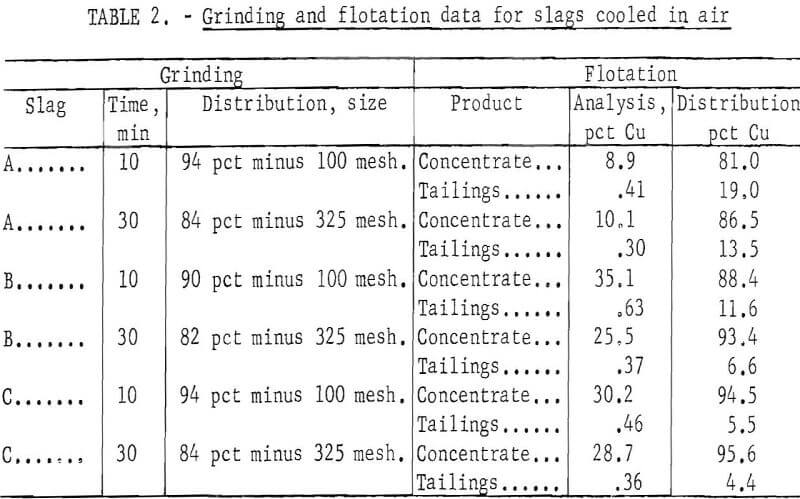
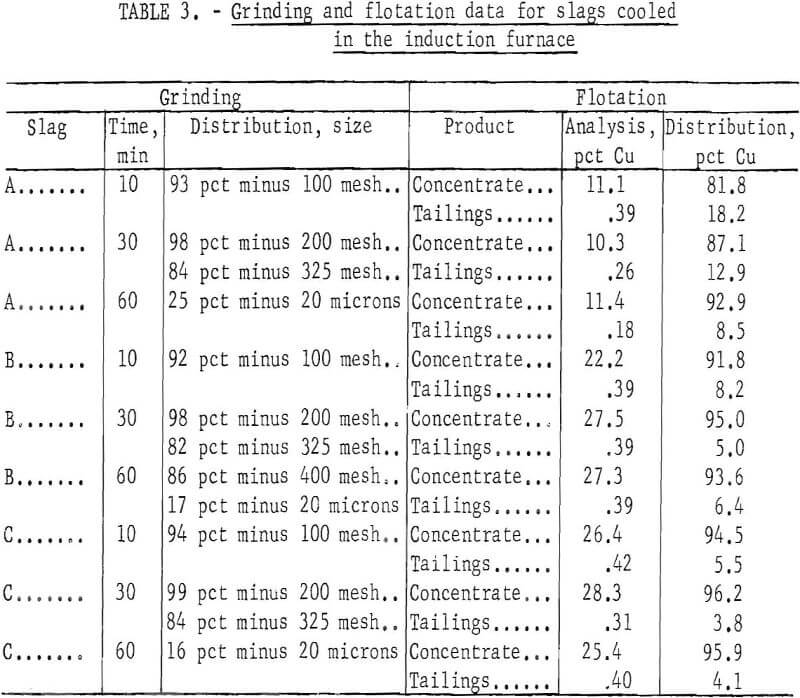
Examination of the data indicates that a relatively fine grind is required to liberate the entrained metallic particles. A 30-minute grind resulted in 98 percent of the pulp passing 200 mesh. More than 80 percent was finer than 325 mesh. The copper analysis and distribution in tailings obtained with 30- and 60-minute grinds, as shown in table 3, indicated no advantage for a grinding time exceeding 30 minutes. However, copper analysis of tailings were lower and recoveries in concentrates markedly increased for a 30-minute grind as compared to a 10-minute grind as shown in the tables. A comparison of the two tables shows no significant difference in results obtained from slags cooled in air or in the induction furnace.
Recovery of copper in concentrates from slags cooled in the induction furnace and ground for 30 minutes ranged from 87.1 to 96.2 percent with the best recovery obtained on the highest grade slag sample. Copper content of the flotation tailings, which is the most important indicator, ranged from 0.26 to 0.39 percent.
Rougher flotation data for individual products from slags slow cooled in the induction furnace and ground for 30 minutes are shown in table 4. Similar copper recovery patterns were obtained in flotation tests made on slags prepared at different cooling rates and grinding times.
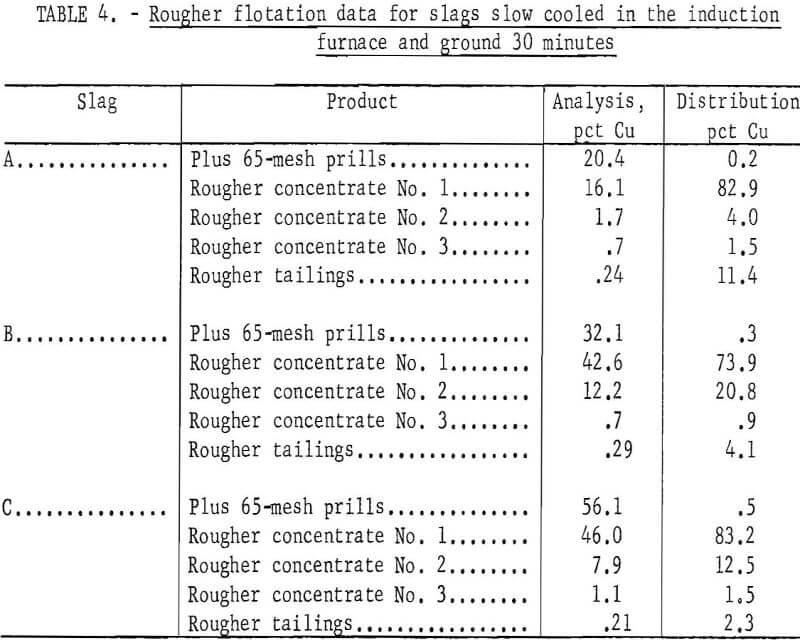
Examination of table 4 shows that the bulk of the copper was recovered in the first and second rougher concentrates. Recovery of copper in the third rougher concentrate ranged from a low of 0.9 percent to a high of 1.5 percent.
The results of the tests on slow-cooled slag show that high recoveries of copper can be obtained in flotation concentrates that could be recycled to the reverberatory furnace. Furthermore, flotation produced a discard tailing that was lower in copper content than the 0.5 percent reverberatory slag usually discarded.
Flotation of Copper from Water-Quenched Converter Slags
The test procedure employed in the flotation of copper from slags remelted in the induction furnace and water quenched was identical with the procedure for treating the slow-cooled slags. Visual observation revealed no distinguishing differences in the flotation characteristics. All slag pulps registered a pH of about 8.5 and exhibited a heavy froth in the first rougher concentrate. There was some color variation in the slags. Water quenched slags were black, whereas slow-cooled slags were dark gray.
The results of the flotation tests after water quenching the three slags are shown in table 5. Higher grade concentrates were obtained from water quenched slags than from slow-cooled slags, as shown by comparing the results given in table 5 with those listed in tables 2-3. However, recovery of copper was about 4 percent lower for the high copper slag (sample C) and 23 percent lower for the low copper slag (sample A). Flotation tailings from the quenched slags ranged from 0.53 to 0.66 percent; slow-cooled slags gave tailings containing from only 0.26 to 0.39 percent copper with lowest analyses for 30-minute grinds.
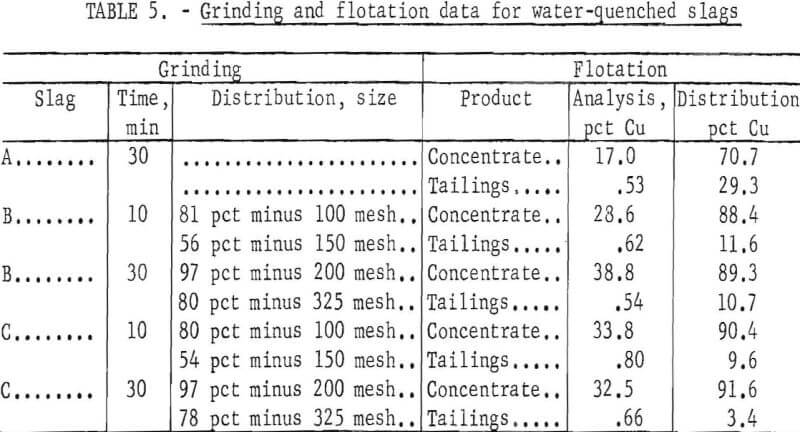
A comparison of size distributions of the flotation feed listed in tables 2-3, and 5 show that for equal grinding time, the water-quenched slags were coarser and more difficult to grind. This indication was substantiated in subsequent grindability tests.
Tailings from both the slow-cooled and water-quenched slags were examined under the microscope. Practically all the discrete free copper-copper sulfide particles had been floated from the slag. The few remaining particles of copper sulfide were locked with the slag.
Grindability Determinations
In preparation for flotation, molten converter slag may be either water quenched or slow cooled. The method of cooling employed in a commercial operation would be dependent upon the floatability of copper from water-quenched versus slow-cooled slag, the initial and operating cost of the installation required for quenching or slow cooling the slag, and the grindability of the respective slags. Grindability determinations were made using the standard Bond laboratory ball mill grindability test.
The Bond theory of comminution (1) is widely accepted as a method for predicting the work input in commercial crushing and grinding operations. Ball mill grindability tests permit the calculation of work indices (2) and these indices provide a basis for comparing the grindability of different materials. Numerically, the work index is the kilowatt hours per short ton required to reduce the material from theoretically infinite feed size to 80 percent passing 100 microns. This comminution parameter expresses the resistance of the material to crushing and grinding.
The laboratory ball mill test procedure simulates a closed-circuit, dry-grinding operation employing a 250-percent circulating load at the particular sieve size used in the test. For convenience in this investigation, 65 mesh was selected as the throughput size for the ball mill test because finer sizes give less reliable estimates of work indices. The work indices, based on 80 percent passing 100 microns, were calculated by Bond equations from the data collected in the tests.
The work indices determined for each of the heat-treated converter slag samples are presented in table 6. Also shown in the table are work index determinations made on slag samples A and B as received from the smelter. Examination of the data shows that water quenching renders the slag more difficult to grind than more slowly cooled slags. The average work index for the quenched slags was 18.1. Average indices of 15.6 and 14.7 were recorded for slag air chilled and slow cooled in the induction furnace.
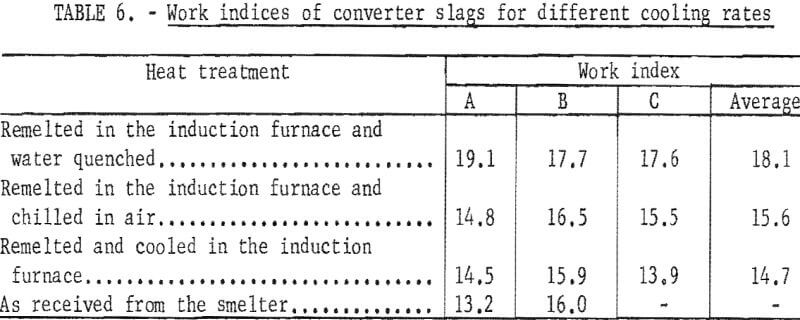
For comparative purposes, grindability tests also were made on two samples of porphyry copper ore and on a sample of limestone. Work indices determined for these materials were 10.6, 15.4, and 11.6. From these data, it would appear that grinding slow-cooled slag would require more energy input than grinding run-of-the-mine copper porphyry ore.
Cost Estimate for the Flotation of Copper from Converter Slags
Cost estimates were made of the economics of floating copper from slow-cooled versus water-quenched slag. Flowsheets for the two methods of treating converter slag are shown in figures 3-4. The treatment shown in figure 3 is similar to that employed at the Naoshima smelter in Japan. It entails slow cooling the converter slag followed by crushing, grinding, classification, and flotation. In the second treatment beginning with a water quench (fig. 4), the crushing operation is eliminated. Evaluations are based on the processing of 500 and 1,000 tons of slag per day,
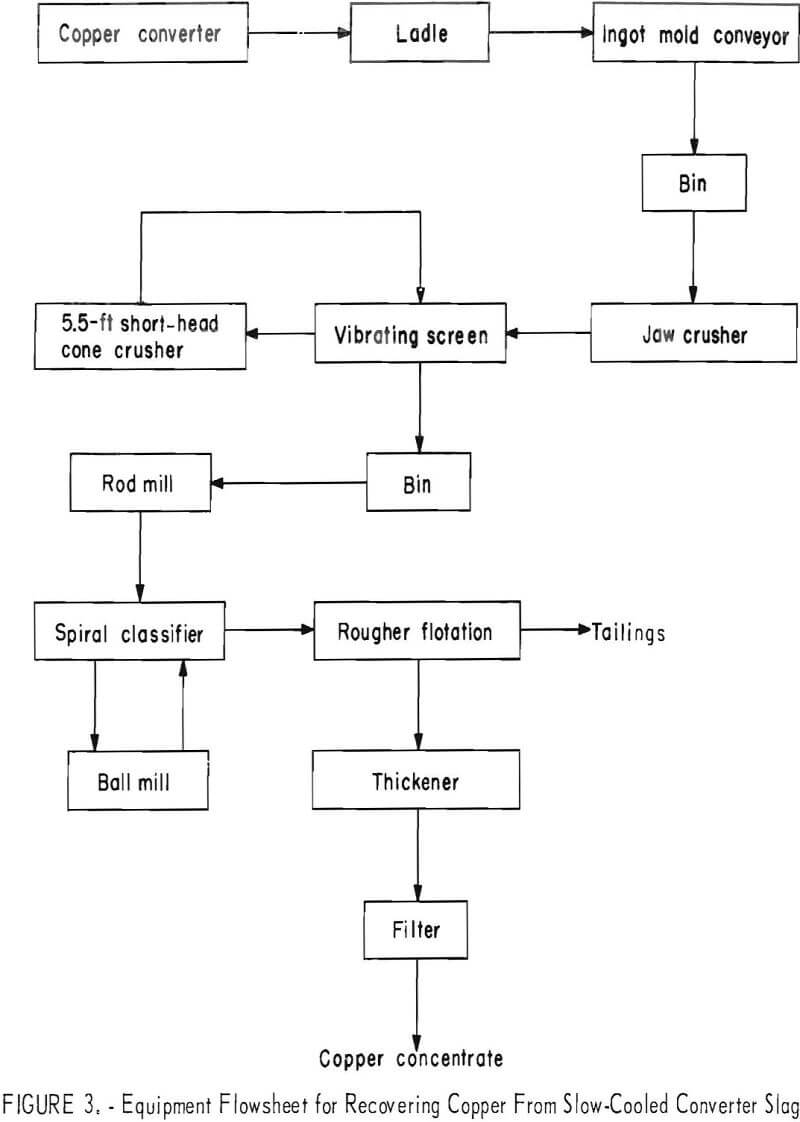
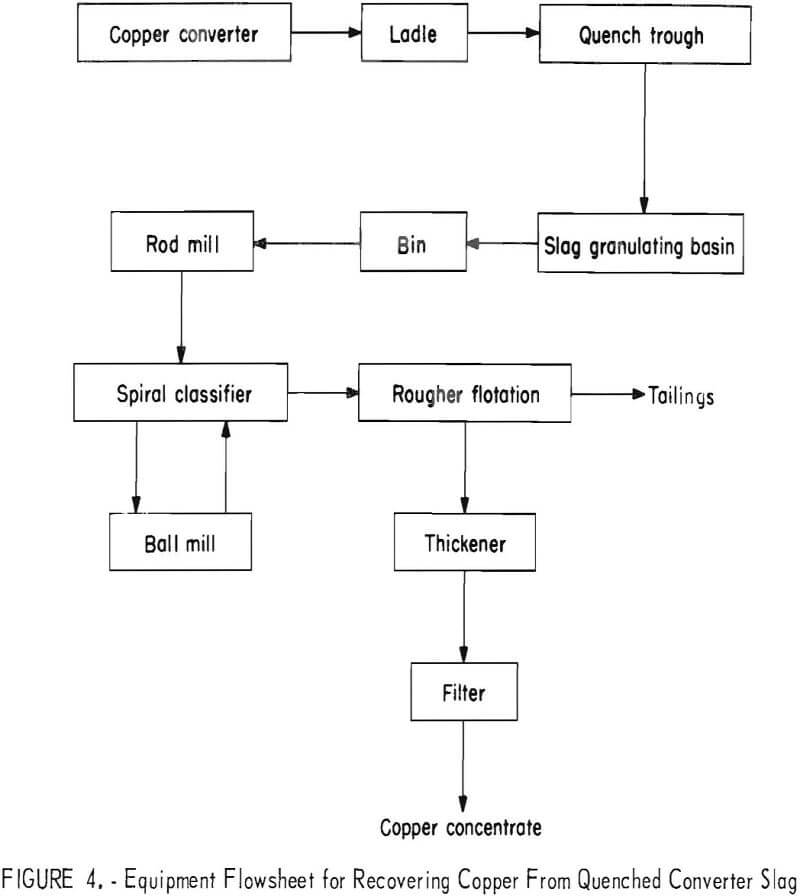
Process for Slow-Cooled Slag
Slag from the copper converter is skimmed into ladles, which are hoisted to a tilting machine. The slag is poured into 10- by 32- by 4-½-inch molds mounted on a 430-foot-long pan conveyor. Each mold is partitioned into three sections that produce slag ingots measuring 10 by 10 by 4-½ inches. A conveyor speed of 7 feet per minute allows about 1 hour for cooling from 1,300° to 300° C. The solidified slag is discharged into a surge storage bin.
The crushing plant operates 7 days per week on the day shift only. In the 1,000-ton-per-day operation, the slag ingots are crushed from 10- to minus ½-inch in two stages. In the first stage, the slag is crushed to minus 2-½ inches in a 36- by 42-inch ton crusher; a 5-½-foot short-head cone crusher further reduces the slag to minus ½ inch. A ½-inch vibrating screen placed ahead of the secondary cone crusher simultaneously removes the undersize from the primary crusher and the oversize from the secondary crusher discharge.
The crushed slag is sent to a storage bin from which it is continuously fed to an open-circuit rod mill. A 62.5-percent solids discharge from the rod mill is sized in a spiral classifier operating in closed circuit with a ball mill. The sands are reground in the ball mill, and the pulp containing 80-percent, minus 150 mesh is pumped to a conditioner where 0.2 pound of KAX and 0.36 pound of MIBC per ton of slag are added. The pulp is then floated in a single stage to produce a rougher concentrate analyzing 21.7 percent copper and representing a 96-percent recovery of the copper from the converter slag. The concentrate is thickened, filtered, and recycled to the reverberatory furnace. The flotation tailing is a converter-slag discard.
Process for Quenched Slag
The treatment of quenched slag is similar to the treatment of slow-cooled slag except for crushing. Slag from the copper converters is skimmed into ladles, transported to a tilting machine, and granulated by pouring it into a quench trough. The size of the granulated slag is sufficiently fine that a crushing step is not necessary. The grinding, classification, and flotation steps are identical with those employed in the treatment of slow-cooled slag.
Cost Evaluation
The cost evaluation was based on 350 operating days per year, 1970 costs, and a 12.5-year depreciation. The total investment required to treat 1,000 tons per day of slow-cooled slag would be $2,739,000 compared with $1,775,000 to treat quenched slag. Operating costs would be $830,000 and $647,000, respectively, for a production cost of $2.37 and $1.85 per ton of slag treated.
For a 500-ton-per-day plant that processes slow-cooled slag and costs $1,921,000, the unit production cost is $3.66 per ton of slag treated. Treating an equivalent amount of quenched slag would require an investment of $1,283,000; cost per ton of treated slag would be $2.95.
Although the recovery of copper from the slow-cooled slag is higher than that from the quenched slag (96 percent as compared with 93 percent), the cost of slow cooling and crushing offsets any advantages gained from the higher recovery.
How to Recover Copper from Slag by Flotation
The relative merits of treating converter slag by water quenching versus slow cooling indicated the following: (1) Water-quenched slags can be treated more economically than slow-cooled slags. Based on the treatment of 1,000 tons of slag per day, production cost of treating quenched converter slag would be $1.85 versus $2.37 per ton of slow-cooled slag. The cost advantage of processing quenched slags results from elimination of the slow-cooling and crushing operations inherent in the treatment of slow-cooled slags. (2) Flotation of slow-cooled slag yields a slightly higher copper recovery and a lower copper tailing. (3) Quenched slags are more difficult to grind than slow-cooled slag. (4) The true economics of a method for re-treating converter slag separately would require consideration of benefits due to increased reverberatory furnace capacities, simplified furnace operations, and possible lower copper content in the reverberatory slags. (5) The amount of copper in the slag had little influence on the residual copper content of the flotation tailing.
